#cluster fusion
Explore tagged Tumblr posts
Text

#steven universe#cluster fusion#forced fusion#cluster steven universe#poppy playtime#doey the doughman#poppy playtime doey
52 notes
·
View notes
Text
ok listen hear me out-

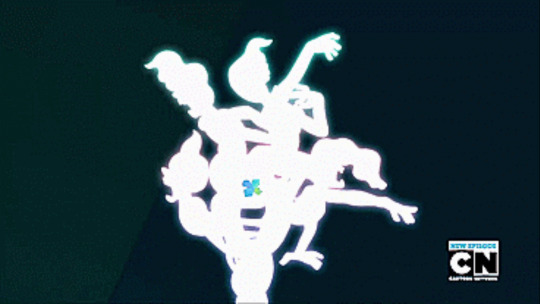
…i mean iM NOT WRONG
#it literally won’t leave my brain#is there a su!au for poppy playtime yet??#if not someone should make one#poppy playtime#poppy playtime chapter 4#doey ppt#doey the doughman#steven universe#artificial fusion su#cluster gems su#the cluster
108 notes
·
View notes
Text
I mean…
Wouldn’t it kinda make sense for White Diamond to give up her form to make Steven in this AU if only because she thought she was helping her planet? This is just a what if scenario… but, what if, when a gem is totally broken beyond repair — like the gem army — their “resources”, their “light” is returned back to the soil? Now, that’s just a theory, because what if that could also explain the strawberry field? A gem’s light can be used to restore “drained” planets because that’s basically what they are. Sentient ecosystems…
#steven universe fandom#alternate universe#au#su#theory#gem war#the cluster?#steven universe fusion#fusions#white diamond#diamond authority#found these in my notes files#I’ve been organizing#lost them once now I’m just rewriting some stuff#all those notes#smh#this is dark#pretty dark#dark theory?#white diamond steven universe#white diamond steven#wd su#wd su au#wd universe#white diamond au
15 notes
·
View notes
Text

4 notes
·
View notes
Text

Shiny Mega Gilgobleye
A Fusion of: Mega Bull Shark (Maneater), Gilgoblin (Warcraft), Gobfin (PalWorld), and Shiny Mega Sableye (Pokemon)
Gender: 50% Male and 50% Female
Element: Neutral, Normal, Dark, Ghost, Fighting, Rock, Psychic, Ground, Flying, Steel, Ice, Fire, Water, Electric, Fairy, Poison, Bug, and Grass
Capabilities: Magic Bounce, Mega Effects, Sonar, Double Jump, Breach Lunge, Air Lunge, Lung Capacity, Angry Shark, Vanguard, Logging Foreman, Motivational Leader, Mine Foreman, Stronghold Strategiest, Lv. 2 Watering, Lv. 1 Handiwork, and Lv. 1 Transporting
Resident to: Poison and Fire
Immune to: Normal, Fighting, and Psychic
Natural Diet: They're Carnivores, and also like to eat gemstones
Natural Habitat: In Underwater, Swamps, Valleys, Golden Cities, Rocky Caves, Towers, Mountains, Volcanic Areas, Steel-related Caves and Mountains, Rallys, Abandoned Amusement Parks, Abandoned Mansions, Caverns full of Mirrors, in Islands, Canyons, Deserts, Cliffsides, Nearing Ponds (Along with Lakes and Seas), Rocky Areas, Ruins, Gemstone Caverns, Flower Plains, Mines, Sand Temples, Light Temples, Abandoned Factories, Abandoned Warehouses, Ghost Japanese Festivals, Abandoned Museums, Gemstone Clusters Outside of Caves, and Haunted Villages
#Mega Gilgobleye#fusion#pokemon#maneater#palworld#world of warcraft#apex level piranha goblin#mega evolution#shiny pokemon#a cluster of emeralds
3 notes
·
View notes
Text
the craziest thing about the energon chronicles au is that technically, i've got ideas for like five slightly different universes sitting under the umbrella for that idea
not five stories. five UNIVERSES.
probably with multiple fics per timeline.
no i am not kidding.
#that's not even mentioning any canon-adjacent tf fic ideas that have nothing to do with my bandom crossover/fusion brainrot#honestly if/when i end up making a sideblog for fic ramblings it'll probably be named after the bandom universe cluster#because of course i have a name for it#grungepo thoughts#grungepo writes#energon chronicles au
0 notes
Text
.......i forgot about syntixi lapidary
#🌺kaltain#oh my gawd da. da fusions.#think uh da cluster#but sort of humanoid and done very particularly
0 notes
Note
Is shattering permanent in the comic (especially with the force fusions and cluster) or can it be fixed down the line like future did? Asking for your opinion on this too bc I found out about it in Future and it makes me feel weird (bc now it feels like any SU stuff and shattering has no consequence or tension, so haven’t been able to read or write stories). Maybe I’m seeing this wrong? Would love your thoughts

Hmm...
So to answer your first question: The comic for WDAU works on the same rules as canon does. I have no intention to over-write anything canon clearly stated to be true.
The ability to put back together shattered gems is definitely a part of that.
So yes, theoretically, even in WDAU, gems being shattered is not 'the end' because they can be eventually re-instated through the work of the diamonds, IF they someday decide to Change Their Minds like they did in the original series.
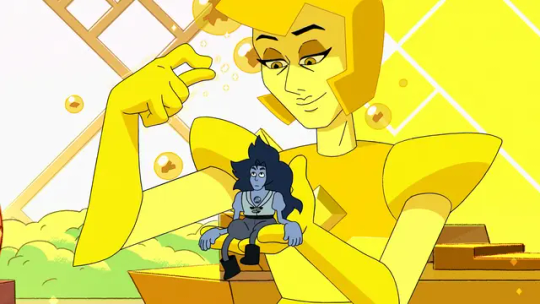
That being said...
I want to talk a little bit about something you said, because it tickles my brain in an interesting way:
"now it feels like any SU stuff and shattering has no consequence or tension"
And the best way to talk about stuff, I've found, is to ask questions about our underlying assumptions. So my questions for you (all) today are:
For us humans, death certainly IS a constant that remains ever-permanent, and thus it's easy to compare it to shattering and draw that parallel... but is that a fair comparison?
In fiction, death is often circumvented and there still remains reasonable tension in things like magic-heavy worlds, vampire novels, sci-fi where almost any sickness is eradicated, etc. Is this not quite similar to what shattering is for gems?
Is the perceived permanency of shattering the only reason it feels like a heavy consequence?
Are there OTHER consequences of being shattered that make it just as interesting, if not more than, to be explored as a plot device?
Must there be an ever-looming threat of something horrible and permanent happening to make a story good?
There isn't a right or wrong answer to these questions, necessarily. I'm not posing these in order to lead you to a singular, 'absolutely correct' conclusion or way of writing.
For some stories, death DOES need to be permanent in order not to make light of what the characters go through! In some forms of writing, there IS no other way around that consequence.
But I daresay SU is not one of those stories.
Let me put it this way - 100 years ago, medicine had only BEGUN to develop into the thing we know it as today. Sure, there were therapies and treatments for diseases, broken limbs, poisonings, etc. Some of them were quite good, even! But overall, the death tolls back then from basic illness were MUCH higher than they were today.
Pnumonia, Malaria, Syphillis, Smallpox, Bubonic Plague, AIDS.
These were things that people died from, with near CERTAINTY, for the LONGEST time. They were considered the road to a permanent black screen.
And today? Even though they are still, without proper intervention, JUST as deadly, we now have new tools and vaccines to combat them. Hell, if you get vaccinated fast enough you can get bit by a rabid dog and live to tell the tale, unscathed! Rabies used to be a one-stop-shop to the afterlife.
Despite this, we still view these diseases with appropriate fear. They are still dangerous - in the right conditions.
In the right conditions, the consequences for a LOT of things can be permanent. If permanency is what you're looking for.
So alright, the Diamonds can heal shattered gems now. Booooring. How easy it is to fix any shattered gem! What a simple solution to anything tragic.
But................... will they ALWAYS do so?
In fact...will the Diamonds ALWAYS be around?
Will the gems who got shattered always be picked up, piece by piece, and be brought back to them, perfectly preserved? Or will they lose pieces of themselves along the way - literally?
And what NEW consequences can we think of, when we stop thinking of the permanency of death, and start thinking of the Impermanence of those tools that keep us here longer and longer?
Just food for thought. 👀
312 notes
·
View notes
Text

Messier 66 taken by Hubble Space Telescope on January 28 2021
In this picture, it showcases the star forming regions of the galaxies, which can be seen in red. Star forming regions are vulnerable to disturbances, which can cause the gas in the interstellar medium to collapse into dense clumps of material. These are called protostars.
During the formation of these protostars, gravitational energy is converted into thermal energy. If there is enough thermal energy produced, it is enough to spark nuclear fusion. The star then joins the main sequence.
Due to nature of the star forming regions, it often yields the creation of star clusters, since many stars are being created in close proximity. Large stars especially can emit radiation and produce stellar winds, which pushes the star away from these regions.
#physblr#physics#astrophotography#astronomy photography#astronomy#astrophysics#cosmology#cosmos#spaceblr#space#hubble space telescope#outer space#hubble telescope#nasa photos#nasa#space exploration#galaxy#galaxies#nasa science#stem aesthetic#physics student#eclipsellium
72 notes
·
View notes
Text
aeon ! reader au
how you came to be and how you met welt welt yang
There was a big bang, and then there was light.
That was how your life started. That was how you were "born." For you weren't a normal living being. You weren't even human. You were the literal essence of stardust coming into an existence.
For instance, you were something that was compressed together within space itself far off into the unknown. With all the gravity and pressure pressing into you; your core started to heat up creating a protostar within the cosmos and soon once your core (your heart) became hot enough to ignite into a fusion, and you were born as a star. A literal one. Yet you looked human, but weren't one. Yet you have a consciousness. You have human hands. Human feet. You have a human face too. Hair, nails, fingers, and toes. You didn't need to breathe, but you could if you wanted to.
"Even if you turn into a black hole and consume all life ... Live freely, just like a shooting star across the cosmos. And come back to me, always. Little aeon."
Those were the last words you heard before you could even open your eyes, and when your heavy eyelids did finally crack open it felt like your reality was shifted momentarily, and you were standing on your own two feet. Clothes were mysteriously materialized onto your body and a language you never knew existed was imprinted into your brain.
And you know right then and there. You weren't just born as a star, but as an Aeon. A higher being that life should bow to. And somehow, with already obtained knowledge, you knew what being an Aeon meant.
That was years ago.
And now, you were bored. Being a higher being above everyone was too mundane for you.
No one challenged your power. All everyone did was ask it from you.
You had an immortal life. Unchanging circumstances. The powerful asking for more. The powerless asking for second chances.
It was all so boring!!
This was why you decided to put that aeon life of yours on hold and walk amongst the mortals and to live as they do. Which was how you found yourself in an abandoned alleyway.
Getting giddy all of the sudden, you took your first steps forward annnnd bumped into someone almost immediately the moment you left the comforts of the alley.
"Careful."
Your face had bumped into someone's chest, her hands grabbing onto someone's arm as you tilted your head a little up. A bright sun shining down as it blinded you. Your eyes squinting as you tried to make out the person's face.
And when your eyes adjusted, you were met with an older face of a man. The sight amazed you. This would be the first time you met someone so different from yourself.
"You...," the man sensed something off about you. Dangerous.
You understood his unsaid questions but you weren't exactly sure how you should answer. You also didn't know how he could sense you so quickly. Was it that obvious you weren't like him?
And how were you supposed to tell him that the universe birthed you and made you an aeon? How were you supposed to tell him that you didn't have "parents"?
And then there was the problem with a name.
In the knowledge you were given it was well known that people usually gave names to planets and stars. Not to mention that when you were born, no one ever gave you a name, not even the people who worshiped you gave you one. Now, some heavenly bodies get the chance to be apart of a cluster to form a constellation and get a name that way. Other Aeons also had names. So did children when they are born.
In other words, you didn't have a name.
So you did the next best thing.
You gave yourself one if the universe wouldn't. You were an aeon after all.
"Y/n."
Despite giving your name, he still seemed guarded. So you tried to continue the conversation, "and you?"
"...Welt. Welt Yang."
You paused as you mulled over his name, "It's nice to meet you Welt Welt Yang," you gave a small bow in greeting.
The man finally smiled at that and shook his head, "I see... so that is the state you are in. My apologies for my earlier apprehension Ms. Y/n. My name is Welt Yang. Not Welt Welt Yang."
You grinned, "I know."
"You.... know?"
"Yep! I just know! Now if you'll excuse me. I have some exploring to do-"
"Wait. Ms. Y/n, if I could have a moment-"
"No time! We'll see each other again, Welt Welt Yang! See ya around!"
#hsr#honkai star rail#aeon reader#aeon reader au#hsr x reader#hsr x aeon reader#various x aeon reader#honkai star rail x reader#honkai star rail x aeon reader
248 notes
·
View notes
Note
What if life evolved in a rogue planet. What would that look like?
This could be surprisingly possible!
Rogue planets, for those who don't know, are planets that don't orbit any star, and wander through interstellar space. They are thought to form around a star, like our Sol's protoplanetary disk, but were ejected by gravitational interaction with other objects during its early formation, for example, two planets forming too close and the smaller one being thrown away with the bigger acting as a gravitational 'slingshot', or a star passing nearby and perturbing their orbit. It's kind of sobering to think that there must be millions, perhaps billions of Earth-like planets that were flung into interstellar space earlier on their formation or even afterwards.
This is not a very pleasant environment, isolated from the warm glow of any star, with temperatures approaching absolute zero. We still don't know much about interstellar space, and I imagine that rogue planets inside the diverse kind of nebulae or near dense star clusters would be very different. But by the most part you can expect them to be dead frozen balls of ice, as EVERYTHING freezes in this temperature. No warmth for any kind of life to be found.
Is this so, though? For starters, brown dwarfs, which are not especifically planets but let's say 'objects' several times the mass of Jupiter, are very hot, being capable of deuterium fusion (unlike hydrogen fusion which is what gives stars their energy). This weak kind of fusion does not allow them to be stars proper, but endures for billions of years. Imagine a gigantic Jupiter glowing in a dull red or magenta. Though it would be interesting to especulate on life in the upper layers of a brown dwarf, or perhaps moons that bask on the weak infrarred it emits, I don't see it particularily likely. On the other hand, organisms can thrive with minimal energy, more on that later. I can imagine, in some remote brown dwarf moon, 'prairies' of incredibly slow photosynthetical organisms growing under the weak light of a brown dwarf.

(here's some artwork of a moon orbiting a red dwarf, with source)
However, these aren't planets in the literal sense. Most rogue planets are indeed likely to be frozen balls of ice and rock. There is no star to warm them up (Earth's diverse biosphere depends on the light of the Sun, as obvious as it sounds), and no kind of life, no matter how exotic, can thrive near absolute zero, molecules just don't move enoguh to allow any kind of metabolism. Even theorized life using ammonia or methane as a solvent instead of water involves temperatures like that of Titan, Saturn's moon, which still gets some sunlight and warmth if minimal, allowing it to retain an atmosphere. Rogue planets just get none.
There are other ways of warming up a planet however. The interior of Earth is still hot from its planetary formation and the decay of radioactive elements on its core, creating volcanic and tectonic activity (though that's still disputed, as it seems that oceans acting as a 'lubricant' is needed for plate tectonics), and it's likely that larger planets would have even greater activity. It's also not the only option, a moon orbiting a large planet would have tidal forces that stretch it, producing similar tectonic activity that could melt the kilometers of ice covering them -water is actually more abundant in space that it seems- and this is indeed what happens in Jupiter's moons Europa and Saturn's Enceladus, as well as the much overlooked Jupiter's Io, which is an incredibly interesting patchwork of volcanoes in frozen temperatures. In fact, astronomers are starting to learn these subsurface oceans are actually the norm rather than the exception.

They are as you might have heard, prime candidates for life. The origin of life on Earth is still one of those debates that send scientists into academic fistfights as you can imagine, but one of the main theories involve it arising from the rich energy and nutrient environment of hydrothermal vents, which would be very common in these kind of worlds. So, if this is true, it's not unlikely that there could be countless worlds like these with life. Returning to rogue planets, subsurface oceans heated by tidal forces don't need any sunlight at all, they just need an icy moon orbiting a big enough planet at the right distance (there are other details, of course, but let's go with the basics). A rogue planet the size of Jupiter or larger could have been expelled from its original system carrying its moons, or could have captured another rogue planet in interstellar space, which would be very interesting as they both would likely have completely different origins and perhaps compositions. Similarily, a tectonically active rogue planet would be enough to melt subsurface oceans, or even surface regions like Yellowstone or Afar on Earth.
What would life look like in these worlds? You can read about speculations of life in Europa and on hydrothermal vents here on Earth to get an idea, but let's talk about it a bit. Now, you might read that hydrothermal vents are an oasis of diversity in the deep ocean with life especially adapted to them, and since they are often relatively short-lived, there are ecological cycles related to them that are still poorly understood. However, do notice that some of the most prominent macroscopic organisms in these places (like say tube worms, isopods, yeti crabs, eels) did not evolve from the extremophile bacteria there themselves, but rather evolved from life from elsewhere (from the rich, sunlit oceans) that adapted to such enviroments. The life *native* to hydrothermal vents on Earth are indeed extremophile, chemosynthetic bacteria and archea, that is, they don't use photosynthesis, their metabolism creates energy and organic structures from the surrounding inorganic chemicals (some very toxic, like sulfides) and heat, no light involved. Unlike most ecosystems on Earth, these chemosythetic organisms are the producers of this isolated food chain, entering symbiosis with other animals not only for food, but also respiration, digestions, and many more things. This is fascinating because it does prove in a very explicit way that chemosynthetic organisms can support complex ecosystems without photosynthesis.

(here's life from an hydrothermal vent, notice the crabs and bivalves, do read the Wikipedia article, it's great)
However, again, do notice that these animals did NOT evolve FROM the bacteria and archaea themselves. They adapted to these extreme enviroments from other animals that evolved in the rich sunlit biosphere of Earth, fed by photosynthesis. If it was by the chemosynthetic bacteria themselves, they would be happy (as much as a bacteria can I guess) to live down there and do chemosythesis forever. There's little evolutionary pressure for them to do anything else.
At least right now. Of course, ironically, these complex simbionts like yeti crabs and tube worms, like humans ourselves, might indeed be distant descendants of primitive hydrothermal bacteria, though from the ones that evolve to use photosythesis and consume those who did, far from the depths, so it means there was some reason for them to evolve out of the vents. Which brings the question; how and why did complex, that is multicelullar life, evolve on Earth, and where else could it evolve? That question deserves its own post or even book.
These are interesting questions to ponder when talking about rogue planets, or indeed any non-photosynthetic ecosystems like cave systems, that are also possible, or perhaps surface volcanic lakes or geysers. Our rich biosphere in Earth is fed by photosynthesis and the endless energy of the Sun. In a rogue planet, the sources of heat, energy and nutrients would be sparse points instead. In our own Earth, the organisms of cave ecosystems have extremely slow metabolisms, something like an olm (blind salamanders that are rather large, up to 40cm long) often stays YEARS in the same place, only moving to (very ocassionally) reproduce and eat. Such ecosystems are not exactly conductive to fast paced, sentient life. But if they are common, there might be millions of them across the universe, and one could especulate some of them might be chillin' on cities build around those vents, or perhaps penetrating the deep ice to see what the outside is like, or basking under nebula light in great hydrothermal systems.
In a similar way, returning to rogue planets, there is also the distressing posibility of an Earth-like world with a developed biosphere being flung away from its star by some freak astronomical event, like some star or indeed another rogue planet passing by and altering the orbits. As you might be very aware, life like Earth would die, and quickly, in this scenario. Again, the only remaining life would be in hydrothermal vents. But it would be interesting to think what kind of civilization could survive. I imagine big cave cities, nearer the underground warmth, fuelled by geothermal or nuclear energy. Perhaps greenhouses and aquariums there would preserve what remains of the biosphere.
And of course, rogue planets and objects would be great stepping stones for interstellar colonization. Perhaps instead of accelerating as fast as they can, long-lived starships might wander from planet to planet, gather resources and perhaps geothermal energy for the next leg of their journey, or settling them to get away from the faster-paced civilizations near bright stars.
If you liked this post and would like to read more, I would really, really appreciate if you gave me a tip to my ko-fi! Being a biologist looking for work in Argentina under a deranged libertarian president with the budget cuts and all is quite hard, so everything really counts!
234 notes
·
View notes
Text
Kingdom Key D and Sora's Heart
Gonna paste some thoughts about Kingdom Key D that struck me last night:
Ok so on the topic of KKD being Sora’s true keyblade aka the one made from his heart (as KKL is made from Riku’s) it just struck me that in kh3 Mickey tells Yen Sid that his keyblade-kkd- was damaged in the realm of darkness along with Way to Dawn breaking in half.
Now we already know the theory that Way to Dawn actually broke during Riku’s sacrifice in the first unseen timeline, lining up with the “drop point” when Riku gets swallowed up by the demon tide in the RoD… but if kkd is made of Sora’s heart and what I suspect about Sora’s heart breaking or being damaged in some way during Riku’s sacrifice in the first timeline…That would perfectly explain why kkd randomly gets “damaged” despite them not even showing it to us and quickly glossing over it!
Think about it. Before kh3 we never even knew keyblades getting broken or damaged was a possibility- because keyblades are extensions of a person’s heart not a truly “physical” object. The only other time we’ve seen a keyblade actually be broken was in recoded when Maleficent breaks data Sora’s keyblade. And the ONLY reason she is able to do this, as explained, is because that keyblade was just a data imitation, it wasn’t tied to a real heart. Until Data Sora gets a heart of his own.
Keyblades don’t just break or get damaged because they get hit by a strong heartless. Sora and Riku have faced stronger enemies that small demon tide plenty of times. No. Keyblades only become damaged if the heart they are extension of become damaged. That has to be it.
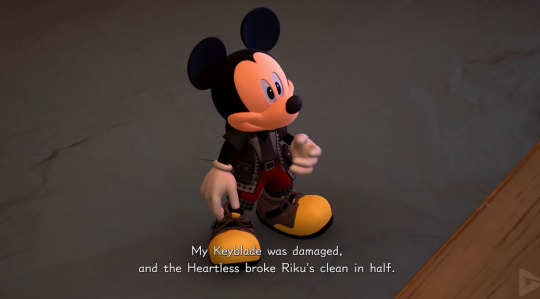
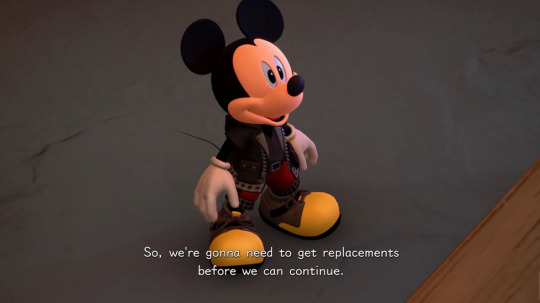
The way Mickey says this and it’s just completely glossed over. Why would they even bother having KKD getting damaged and replaced when it’s an iconic keyblade and they don’t even SHOW the damage. It makes no sense... unless it’s planting a seed. Something to come back to with new context. Rather than getting a full replacement Mickey seemingly fuses KKD with Star Seeker, his bbs keyblade, in order to repair it.

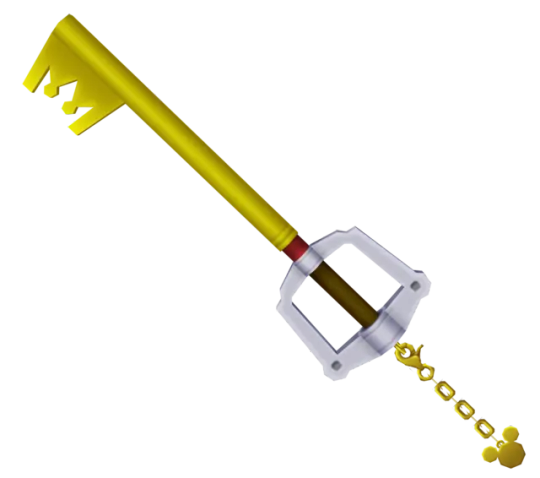
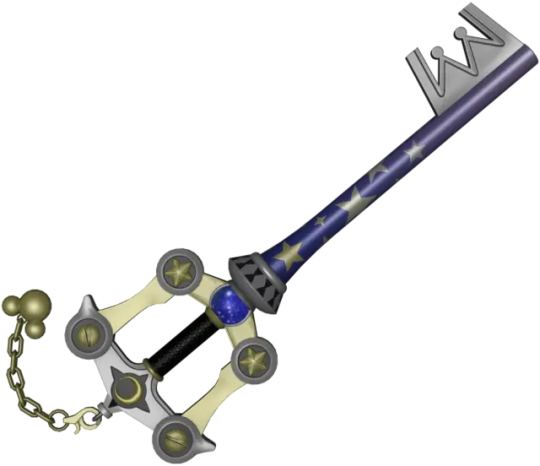
This is also the first time we’ve seen this type of fusion of keyblades, again with zero explanation or showing it happening on screen. Star Seeker also happens to be the keyblade Sora gets with his first drive form, Valor form…
The fusion keyblade is called Star Cluster, and also apparently in jp it is “Kingdom Key W” (what does the W stand for??) The Star/Galaxy aesthetic also reminds me of that starry space in ReMind where Sora connects constellations…
Other things:
Apparently in Japanese the letter W is very commonly used as an idiogram for "Double" or "Two". This would make sense for a fusion keyblade like Kingdom Key W. Other ideas that were suggested: W for Waking, W for the "Win" timeline (as the previous timeline was fated to be lost to darkness). It's possible it has multiple meanings.
2. “Only King Mickey can open a door to the realm of darkness. It’s because he has a special Keyblade of Darkness. He figured out how to make it open the way.”
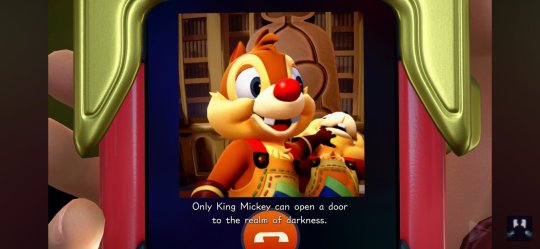

As stated in the kh3 glossary there are only three ways to enter the realm of darkness voluntarily: Beings of darkness have the power to open paths to it, a special keyblade of darkness (of which I believe KKD is the only known example- Nomura has explained that it doesn't mean that the keyblade's nature is dark or evil, only that it's a key that works on doors to/from the RoD), and the power of waking (which Sora uses to reach Riku).
I just think it's interesting if KKD is made from Sora's heart it just so happens to be this special keyblade of darkness. It's a complete mystery as to why KKD was just sitting there on the dark side of Destiny Islands. Mickey seems to know that it's a counterpart to KKL and that it would appear where KKL appeared....but how did he know that? What does it mean? Another interesting connection- during the fall of Destiny Islands notice how the door from Sora's dive to the heart appears in front of the Secret Place, and how the door within the cave only blasts wide open when Sora gets near.
Anyway, I've always thought KKD getting damaged was wierd and suspected it had something to do with what happened in the first timeline but assumed it had to do with Mickey's heart getting damaged somehow. But this makes so much more sense to me- after all we know KKD isn't made from Mickey's heart, it was just a keyblade he found. For both Way to Dawn and KKD to have become damaged as a result of Riku's sacrifice, due to whatever happened to Sora and Riku's hearts....it just makes sense. Sora's heart was damaged, so of course the keyblade made from him would be too.
222 notes
·
View notes
Text
Apparently, Steven Universe has been getting traction again, and unfortunately I've found this out through social media memes saying how bad of a mother Rose Quartz was.
People say she's a horrible mother because the burdens of her past were handed down to Steven. Now, while it's true that he had to deal with her past problems, Rose had NO WAY of knowing that would happen! Let me put things in perspective.
Rose never intended for Steven to bear the fallout of the war. When Rose was still alive, she and the Crystal Gems truly believed the war was over for more than 5000 YEARS.
The only aftermath of it was the corrupted gems that they were capturing, and for a long time, the Crystal Gems shielded Steven from them and didn't let him go on missions.
For 5000+ years since the war, there was peace, and that's when Rose had Steven.
NOBODY on Earth knew about Homeworld's fusion experiments and the Cluster. There was no contact from Homeworld until roughly 12 years after she had Steven, when they sent the Red Eye in episode 2.
I'm so sick of Rose being a scapegoat for all of the show's conflicts that happened AFTER SHE DIED.
159 notes
·
View notes
Text
WHAT CAUSES A STAR TO SHINE??
Blog#475
Wednesday, January 29th, 2025.
Welcome back,
Astronomers estimate that the universe could contain up to one septillion stars – that’s a one followed by 24 zeros. Our Milky Way alone contains more than 100 billion, including our most well-studied star, the Sun.
Stars are giant balls of hot gas – mostly hydrogen, with some helium and small amounts of other elements. Every star has its own life cycle, ranging from a few million to trillions of years, and its properties change as it ages.
Stars form in large clouds of gas and dust called molecular clouds. Molecular clouds range from 1,000 to 10 million times the mass of the Sun and can span as much as hundreds of light-years.

Molecular clouds are cold which causes gas to clump, creating high-density pockets. Some of these clumps can collide with each other or collect more matter, strengthening their gravitational force as their mass grows. Eventually, gravity causes some of these clumps to collapse. When this happens, friction causes the material to heat up, which eventually leads to the development of a protostar – a baby star. Batches of stars that have recently formed from molecular clouds are often called stellar clusters, and molecular clouds full of stellar clusters are called stellar nurseries.

At first, most of the protostar’s energy comes from heat released by its initial collapse. After millions of years, immense pressures and temperatures in the star’s core squeeze the nuclei of hydrogen atoms together to form helium, a process called nuclear fusion. Nuclear fusion releases energy, which heats the star and prevents it from further collapsing under the force of gravity.
Astronomers call stars that are stably undergoing nuclear fusion of hydrogen into helium main sequence stars. This is the longest phase of a star’s life. The star’s luminosity, size, and temperature will slowly change over millions or billions of years during this phase. Our Sun is roughly midway through its main sequence stage.

A star’s gas provides its fuel, and its mass determines how rapidly it runs through its supply, with lower-mass stars burning longer, dimmer, and cooler than very massive stars. More massive stars must burn fuel at a higher rate to generate the energy that keeps them from collapsing under their own weight. Some low-mass stars will shine for trillions of years – longer than the universe has currently existed – while some massive stars will live for only a few million years.
At the beginning of the end of a star’s life, its core runs out of hydrogen to convert into helium. The energy produced by fusion creates pressure inside the star that balances gravity’s tendency to pull matter together, so the core starts to collapse. But squeezing the core also increases its temperature and pressure, making the star slowly puff up. However, the details of the late stages of the star’s death depend strongly on its mass.

A low-mass star’s atmosphere will keep expanding until it becomes a subgiant or giant star while fusion converts helium into carbon in the core. (This will be the fate of our Sun, in several billion years.) Some giants become unstable and pulsate, periodically inflating and ejecting some of their atmospheres. Eventually, all the star’s outer layers blow away, creating an expanding cloud of dust and gas called a planetary nebula.
All that’s left of the star is its core, now called a white dwarf, a roughly Earth-sized stellar cinder that gradually cools over billions of years.

A high-mass star goes further. Fusion converts carbon into heavier elements like oxygen, neon, and magnesium, which will become future fuel for the core. For the largest stars, this chain continues until silicon fuses into iron. These processes produce energy that keeps the core from collapsing, but each new fuel buys it less and less time. The whole process takes just a few million years. By the time silicon fuses into iron, the star runs out of fuel in a matter of days. The next step would be fusing iron into some heavier element but doing so requires energy instead of releasing it.

The star’s iron core collapses until forces between the nuclei push the brakes, then it rebounds. This change creates a shock wave that travels outward through the star. The result is a huge explosion called a supernova. The core survives as an incredibly dense remnant, either a neutron star or a black hole.
Material cast into the cosmos by supernovae and other stellar events will enrich future molecular clouds and become incorporated into the next generation of stars.
Originally published on https://science.nasa.gov
COMING UP!!
(Saturday, February 1st, 2025)
"WHAT WILL IT TAKE TO REACH ZERO SPACE DEBRIS??"
#astronomy#outer space#alternate universe#astrophysics#universe#spacecraft#white universe#space#parallel universe#astrophotography
39 notes
·
View notes
Text
I can't help but wonder just how the battlemech's development and its attendant industrial systems and doctrine endured in the first place during the Age of War and then survived the resumption of total warfare during the Amaris Rebellion and Succession Wars.
I can accept maybe it's a great deal like the MBT in a modern military lens but the problem is they seem to be a great deal more vulnerable to impact and especially the possibility of being blasted over by massive explosions. That's to say nothing of how in economic terms there is no comparison.
A Locust, the cheapest and cheeriest of the cheap and cheerful 'mechs, is half the price of a Demolisher superheavy tank able to lay waste to just about anything in its reach- and the battlemech's monstrous collateral costs are nothing like the MBT, after all. I really don't think we'd still have tanks in modern war if they were as expensive as jet fighters, no matter how wowcool they are for soldier boys and procurement offices.
And again- if they were as vulnerable as aircraft and took the same kind of specialized training, logistics, and sustainment investment, it would be unfathomable.
Even setting aside the genocidal character of a thermonuclear PSR, if an Arrow IV- a short-range tactical cruise missile with a conventional high-yield unitary or cluster warhead- can wreck an entire 'mech formation's future, why wouldn't any of the major powers use nukes on them prima facie? And especially what I suspect would be much better and more powerful and functionally cleaner weapons when controlled fusion reactions are universal for energy generation.
It seems semi-inconceivable the battlemech was seen as anything but a non-starter when ubiquitous light accurate nuclear ordnance would make economic insanity of concentrating them for major engagements- to say nothing of their vulnerable logistics train.
I feel it would've been much better in narrative terms had the battlemech and its chivalric individualist culture been pushed as an alternative to the indiscriminate devastation of mass strategic-nuclear war across the cosmos.
And I understand the Ares Conventions sort of achieve this but they involved no systematic disarmament nor any particular concern for adherence to their norms until the Succession Wars themselves made such mass destruction first untenable and then essentially impossible.
If anything, it seems more plausible it should have been the Inner Sphere to develop a zellbrigen culture and the Clans to be more legalistic and inflexible around the protection of scarce infrastructure.
36 notes
·
View notes
Note
I have a question about who we are in the story. Are.. we the fusion of all the humans that were lost to the woods or are we truly the fourth wall looking in?
Cause if the former is true, I can kinda see us like the Cluster from Steven Universe. Different, broken, pieces merging to make a new whole.

It's just you.
There you are.
((Non cryptic answer: For narrative purposes, I cannot say.))
39 notes
·
View notes